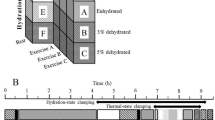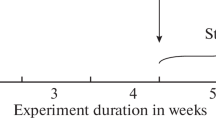Abstract
The effect of heat (Ta = 35°C, 70–90% rh) respiratory rate, rectal temperature (Tre), plasma and urine osmolarity, and of [Na+] and [K+] in plasma and urine in four different age/weight groups of pigs were investigated. At thermal neutral temperatures the measured physiological functions remained constant over 3 hours. At 35°C and 70–90% rh rectal temperature rose gradually. At the same time, there was a rise in respiratory rate, a slight increase in plasma osmolarity and a rise in plasma [K+] but a fall in plasma [Na+] in all four groups. The animals salivated profusely as soon as a rectal temperature of 40.5°C was reached. The urine osmolarity rose from normal to a maximum at a rectal temperature of 40.5°C and thereafter decreased. The urine [Na+] fell with increasing rectal temperature whereas the urine [K+] increased.
Zusammenfassung
Schweine in vier verschiedenen Alters- bzw. Gewichtsstadien (20–25 kg, 40–45 kg, 60–65 kg und 90–95 kg) wurden vergleichsweise 16° bis 23°C und in der Klimakammer bei 35°C und 70–90 RF ausgesetzt. Bei erhöhter Ta stieg die Rektaltemperatur (Tre) und gleichzeitig trat in allen 4 Gruppen eine Erhöhung der Atemfrequenz, eine geringgradige Zunahme der Plasmaosmolarität, sowie eine Hyperkalämie und Hyponatriämie ein. Stieg die Tre über 40.5°C setzt eine starke Speichelsekretion ein. Die Harnosmolarität nahm bis zu einer Rektaltemperatur von 40.5°C zu, um dann wieder abzusinken. Die Na+-Konzentration im Harn sank mit der Erhöhung der Tre ab, während die K+-Konzentration anstieg.
Resume
Des porcs de 4 classes d'âge ou plus exactement de 4 groupes de poids (20 à 25 kg, 40 à 45 kg, 60 à 65 kg et 90 à 95 kg) ont été placés soit à des températures neutres de 16 à 23°C, soit en chambre climatisée par 35°C et 70 à 90% d'humidité relative. Par température neutre, les fonctions physiologiques restent constantes durant 3 heures au moins. Par température élevée, la température rectale (Tre) se relève et, parallèlement, on constante dans les 4 groupes une augmentation de la fréquence de respiration, une faible augmentation de la pression osmotique du plasma ainsi qu'une hausse des ions [ K+ ], mais une diminution des ions [Na+] du même plasma. Les animaux ont commencé à saliver abondament dès que Tre a atteint 40,5°C. La pression osmotique de l'urine a augmenté régulièrement de la normale jusqu'à un maximum atteint lorsque Tre est arrivé à 40,5°C. Elle a diminué ensuite même si Tre dépassait ce seuil. La concentration du sodium diminue avec la hausse de Tre alors que celui du potasse augmente. On discute enfin le rôle que jouent les paramètres mesurés dans la régulation de la température et du bilan de l'eau.
Similar content being viewed by others
Literatur
BEAKLY, W.R. und FINDLAY, S.D. (1955): The effect of environmental temperature and humidity on the frequency of the heartbeat of Ayrshire calves. J.agric.Sci., 45: 461–465.
GEORGIEV, S. (1970): Beitrag zur Feststellung einiger physiologischer Parameter bei der Einwirkung der industriellen Schweineproduktion. 16th European meeting of Meat Research Workers, Sofia-Warna, 1: 264–270.
GEORGIEV, S. (1971): Wirkung der Umgebungstemperatur auf den Wasser-und Elektrolythaushalt des Schweines in verschiedenen Entwicklungsstadien. Berl.Münch.tierärztl.Wschr., 84: 118–119.
GEORGIEV, S. und STEINHARDT, M. (1971): Veränderungen der Osmolarität von Plasma, Harn und Speichel beim Hausschwein in exogener Hyperthermie. Arch.exp.Vet.med., 25: 214–221.
GEORGIEV, S., STEINHARDT, M. und LYHS, L. (1971): Untersuchungen zur Hyperthermie beim Schwein in verschiedenen Entwicklungsstadien. Arch.exp.Vet.med., 25, 6.
HAINSWORTH, R. (1967): Saliva spreading, activity and body temperature regulation in the rat. Amer.J.Physiol., 212: 1288–1292.
HOLMES, C.W. and MOUNT, L. (1966): Effect of ambient temperature on heart loss, weight-grain and water consumption of young pigs. Anim. Prod., 8: 363–367.
HÖRNICKE, H. (1962): Die Körperzusammensetzung normal ernährter Schweine im Verlauf des Wachstums. Z. Tierphysiol., Tierernähr., Futtermittelk., 17: 28–31.
INGRAM, D.L. (1964): The effect of humidity and temperature on heat loss and thermal insolation in the young pig. Res. vet. Sci., 5: 357–360.
INGRAM, D.L. (1965): Evaporative cooling in the pig. Nature (Lond.), 207: 415–416.
MOUNT, L.E. (1962): Evaporative heat loss in the new-born pig. J.Physiol.(Lond.), 164: 274–281.
MOUNT, L.E. (1968): The Climatic Physiology of the Pig. Edward Arnold, London, pp. 271.
ROBINSON, K. and LEE, H. (1941): Reaction of the pig to hot atmospheres. Proc.roy.Soc. (Queensland), 53: 145–149.
STUDZINSKI, T. (1968): Exkretionsfunktion der Niere und Speicheldrüse beim Hausschwein in exogener Hyperthermie. Mh. Vet. Med., 23: 664–666.
STEINHARDT, M. und GEORGIEV, S. (1970): Untersuchungen über den Einfluss hoher Umgebungstemperatur auf einige Faktoren des inneren Milieus beim Schwein. 16th Europ.meeting of Meat Research Workers, Sofia-Warna, 1: 171–177.
STEINHARDT, M. und STUDZINSKI, T. (1967): Besonderheiten und Grenzen der Herzkreislauf- und Atmungsfunktion des Schweines bei der Thermoregulation. Mh.Vet.med., 24: 985–992.
STEINHARDT, M., STUDZINSKY, T., LYHS, L. und BORCHARDT, D. (1970): Thermoregulatorische Hyperventilation, Speichel-und Harnabgabe bei Hausschweinen in exogener Hyperthermie. Arch.exp.Vet.Med., 24: 793–800.
Author information
Authors and Affiliations
Rights and permissions
About this article
Cite this article
Georgiev, S. Wirkungen höher Umgebungstemperaturen auf den Wasser—und Elektrolythaushalt des Schweines in verschiedenen Wachstumsstadien. Int J Biometeorol 16, 145–154 (1972). https://doi.org/10.1007/BF01810285
Received:
Issue Date:
DOI: https://doi.org/10.1007/BF01810285




